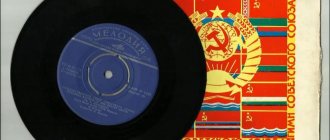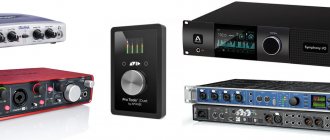Despite widespread digitalization and the popularity of online media players, vinyl records remain in demand. They are preferred by representatives of a wide variety of musical styles - from classic rock to jazz, from rock and roll to electronic music. And this is not surprising, because this type of medium allows you to practically touch something that does not have a material appearance. Only vinyl allows you to enjoy the atmospheric sound of your favorite compositions. To get to know this phenomenon better, you need to understand how a vinyl record works. You can find your favorite compositions and albums on vinyl in specialized stores that sell vinyl records.
A vinyl record (gramophone record, vinyl) is an analog sound carrier, presented in the form of a single- or double-sided disc. As a rule, in the manufacture of this disc, synthetic materials are used, on the surface of which a continuous winding path is applied. It is she who displays sound waves.
Vinyl is used to record and reproduce audio, not graphic information. Usually you can find musical compositions, literary works, sounds of nature, and humorous performances there. Copies that were recorded in the last century are now coveted by collectors and fetch hundreds of dollars.
If you look at the surface of a vinyl record under a microscope with 1000x magnification, you can see that uneven grooves have been scratched into it. It is by moving along them that the pickup needle reproduces the recording. This is the principle of operation of a vinyl record.
Depending on the pattern on the walls of the sound tracks, vinyl can be stereo or monophonic. The grooves of stereophonic vinyl are designed in such a way that the sound they produce is picked up differently by the left and right ears. This is explained by the fact that different patterns are applied to the right and left walls of the grooves. On monophonic records they look the same, and the groove itself is shaped like the Latin letter V.
In addition, there is quadraphonic vinyl, information on which is recorded on two rear and two front sound channels. Although it can be used to convey the volume of a musical composition, it is not widely used. This is because quadraphonic records require expensive turntables and four-channel amplifiers to play.
The sound recorded on a vinyl record is reproduced using a stereo head. It is equipped with two piezoelectric crystals located perpendicular to each other, and in relation to the plane of the plate - at an angle of 45 degrees. Moving along the uneven surface of the grooves, the sound pickup needle picks up shocks from the right and left, begins to vibrate and transmits vibrations to the transducer. The transducer, which looks like a membrane, transmits the sound to the amplifier, causing it to become louder and more spacious. On modern equipment, sound is transmitted to the phono preamplifier, from it to the amplifier, and then to the speakers.
The history of the recording industry began with records.
Apart from early experiments with wax rollers and something only vaguely reminiscent of modern records back in the 19th century, the starting point for “vinyl” can be considered February 26, 1917. Then in New York, in the building of the Victor Talking Machine company, the first commercial gramophone record was recorded. And on March 7 of the same 1917, it was officially released. A quintet from New Orleans, the Original Dixieland Jazz Band, was recording. Yes, the first commercial gramophone record in history featured jazz, and even from white musicians.
It is worth clarifying that previously music on records had already been released, but these were mainly excerpts of classical works. It was the ODJB recording - which became extremely popular - that launched the recording industry, and at the same time seriously popularized jazz. Surprisingly, before this no one sought to record and sell their music, although there had been opportunities since the beginning of the century.
However, the early music of ODJB can only be called jazz jazz. The quintet's musicians were of Celtic and Italian blood, and began by playing in a marching band. They learned about jazz while touring in Chicago. Then they realized that interest in this new southern music was growing. Returning to New Orleans, the musicians created a “jazz” ensemble - this was in 1916, and it existed until 1925. The quintet's musical skills were enough to copy the sound of the “black” ensembles quite closely. And in the end, they also earned recognition - the composition Dixie Jass One-Step from their debut album was subsequently often played by black musicians.
Even earlier - in 1916 - a real jazz quintet, the Versatile Four, recorded on a record. However, their recording was released much later, so the Original Dixieland Jazz Band is still considered the pioneers.
The phonograph record quickly became an industry standard—despite its shortcomings.
At first, the records contained only one or two songs per side. Because of this, selections of musicians’ works were sold in paper or leather albums, into which several records were placed at once. This is where the term “music album” comes from. In addition, the sound quality was not the best, the shellac from which records were made then easily deteriorated, and recording was carried out only in mono - and these are just the most obvious problems. But records were easy to produce, and the equipment to play them was reasonably priced. This ensured the popularity of the format. In addition, in the late twenties, electric microphones replaced analog recording with horns, which greatly improved the quality of recording on records.
But the real breakthrough came in 1948. Then Columbia Records introduced the first Long Play format record: 12 inches in diameter and with a speed of 33⅓ revolutions per minute. Without going into technical details, this format has greatly improved the sound quality and expanded the dynamic range of recordings. But what’s more important is that now the record could fit much more, up to 30 minutes of recording on each side. It was possible to fit an entire music album onto one medium, unprecedented freedom for that time! Such records were made from a material called polyvinyl chloride - that’s why they were vinyl. Recording and record production technologies have improved over the years, but the LP format is still the standard.
The use of vinyl made it possible to reduce the width of the sound groove several times, due to this the capacity of the records increased.
Songs on bones and turtles
The vocalist of the British band The Real Tuesday Weld, Stephen Coates, who was on tour in St. Petersburg in 2012, made an unexpected discovery for himself in our Northern capital. Once at a local flea market, he became interested in a vinyl record rack. Among them, he suddenly saw an x-ray with a hole in the middle; It turned out that on such an unusual medium in the USSR at one time music that was prohibited or inaccessible to the general Soviet public was clandestinely distributed. Such “masterpieces” of recording were once called “bones” or “music on the ribs.” Such underground sound recording had never been seen in the West, so this phenomenon interested Coates extremely much, to such an extent that he, along with his friends, photographer Paul Heartfield and music researcher Alex Kolkowski, thoroughly studied the history of this issue. As a result, he not only wrote a book, but also made a documentary film on this topic, and also became the organizer of a number of thematic exhibitions telling about underground Soviet recording studios. “Music on the ribs” was an invention of our craftsmen and was distributed only on Soviet territory. Many of the younger generation of Russians cannot even imagine that their grandparents listened to criminal songs, White Guard and Western music on media made from X-rays with real skulls and bones. At the level of modern gadgets, this already seems like some kind of “Neanderthal” tale, but it really happened, and I will try to tell how everything really happened. Those who lived during the era of the USSR remember very well the songs of those years, usually reminiscent of military marches, they often lacked lyrics, some soul-touching human experiences, literally everything came down to the wonderful life of those who are building developed socialism and communism. I’ll be honest, I like many songs from that time, and sometimes I even hum them, maybe it’s my age - I was born in 1955. However, at the same time, in my youth, I constantly felt the need for much greater musical diversity, therefore, listening to music and songs that were not available in the USSR, I often felt real delight. It is worth noting that even before the war, Joseph Stalin himself personally decided to try the influence of “Western music” on himself. In the fall of 1940, Rosner's jazz orchestra was suddenly invited to Sochi, where they were forced to play in front of an empty hall. There was still a spectator at this concert; it was Stalin himself, who was sitting in a curtained box. Surprisingly, he liked this concert. This may have delayed Rosner’s arrest for several years, but in 1946, due to the persecution of performers of “Western” music, he was nevertheless sent to Kolyma.
Magnetic tapes, CDs and streaming services tried to kill vinyl - but they couldn’t.
Of course, over time, more modern, simple and cheaper sound carriers appeared: reels, compact cassettes, CDs. Against this backdrop, sales of vinyl records have decreased significantly - since about the 90s, the situation with vinyl has been getting worse. Records somehow survived thanks to audiophiles and the shortcomings of new formats. The records are quite fragile and not very durable. However, they can still provide excellent sound quality. Vinyl is also not affected by electric and magnetic fields.
There is nothing to say about the digital era, which started at the beginning of the 2000s. Yes, mp3 files downloaded from the Internet are not even close to the quality of vinyl recordings, but how convenient! And the durability is unsurpassed: nothing will happen to the file, and you can copy it at least a million times by pressing just a couple of buttons. And then streaming came, you don’t even need to download or copy anything anymore. Who cares about quality when music is consumed mainly on the run. Here the old-fashioned vinyl would have completely died, but it suddenly raised its head.
How to deal with “vinyl”: what you need to know about the records we buy
The process of collecting records (in other words, “vinyl”) is steadily gaining momentum. If previously experienced music lovers looked condescendingly at young people who succumbed to fashion and swept everything off the shelves, not paying attention to labels, years of production, and often the condition of this or that plastic, now the proud snobbery of the “older comrades” has been replaced by outright fear.
Active young people who speak English are able to not only search for the necessary discs on the Internet, but also go directly to Europe for them, establish contacts and (oh, horror!) get into the most cherished area - selling discs to the public. In specialized groups on social networks, “veterans of the movement” snarl, bare their teeth and bend their fingers, but the process goes well even without them.
Photo: m24.ru/Lidiya Shironina
Interest in vinyl is growing. And now it’s not so easy to find the first editions of many “classic” rock records and rare labels. There is a slight danger of being deceived not just by a poorly dressed speculator from the Soviet era, but by a well-trained manager.
Ivan P., a collector and manager of the Gramzapis store, shares his advice on how to feel more confident in the world of vinyl.
Photo: m24.ru/Lidiya Shironina
Vinyl ticket
I came to vinyl in the mid-80s, when I still lived in Eastern Siberia. My dad, a researcher, introduced me to one of his former students. Probably, having decided that if a child is already interested in some kind of “heavy metal”, then let him deal with normal people, and not with who knows what literates in the forests and gateways. This former student (thanks to him!) brought me to important people and said that I was the son of a serious man, and that I myself was already very serious, and that I could be trusted with records. Each of them cost the same as the average salary. Soon I was actively listening and rewriting.
Photo: m24.ru/Lidiya Shironina
Air tickets were inexpensive then and we flew for records to Moscow, Gorky (Nizhny Novgorod), St. Petersburg, and the Baltic states. In 1991, the socio-political formation in the country changed: everyone was allowed to open shops. The older generation opened shops selling records, and I actively participated in all this. During the period of almost complete loss of people's interest in vinyl (from 1994 to the early 2000s), it was almost impossible to sell records. I still haven’t gotten over this childhood impression. It's probably not worth trying anymore. Moreover, there are a lot of records. And you can buy them easily. In any case, an air ticket is usually not needed for this.
Record, why did you come back?
Firstly, there are still a large number of people alive on the planet who remember the “vinyl” (LP) format from the time when it was the main one. And the impressions of childhood are the most lasting. Secondly, a vinyl record is a more tangible item than a compact disc (CD). No matter how hard artists and designers try to cram something in there, it still won’t look good. Thirdly, what was released on LP, in the CD version, in my opinion, sounds like a pan at a march of hungry pensioners. Everything turns into some very simple and not particularly lively music.
Photo: m24.ru/Lidiya Shironina
Is “vinyl” an old man’s joke?
More and more young people are buying records. Guys and girls watch how grown-up guys (some even decent-looking ones) frantically run around with these records. No matter how the younger generation demonstrates their independence, they will use the experience of the older generation as an example. They can't get some interesting example from the Moon or Mars.
Remakes and first presses
Personally, I treat reissues (“remakes”) calmly, that is, indifferently. At the same time, one cannot deny the fact that a bunch of new albums have been released over the past 15 years, and if this music arouses interest in the “vinyl” version, then you need to buy these records. A certain contingent of people are not aware of the existence of circulation of old original records. A common reaction to the “original” of the 60s: “Is she old?” It is assumed that everything there is scratched, cockroaches, flies, and other septic crime lie on it in an even layer. But over the past five to seven years, as soon as there was more or less mass interest in old records, all the more or less interesting titles from among those that just yesterday were lying around on every corner for pennies were simply washed out of the market.
Photo: m24.ru/Lidiya Shironina
Remakes are divided into two types. In the first case, a file recorded from a CD is sent to the plant, and at the output we have a CD rolled on black plastic, slightly ennobled with black plastic. In the second, leisurely professionals find somewhere a reel with the original recording, transfer it to a matrix and print records from it, which can be no worse than the original ones. If a person listened to Led Zeppelin in 1969, he would probably find “10 differences” and spit. If a person was born in 1989 and wants to get acquainted with the work of this group, then this disc is an excellent choice for him. Like the very first original from 1969, most of them will simply be unaffordable.
In the 70-80s, a huge number of records by popular artists at that time were released and one can assume that they will never end. I will say on my own behalf: if a person seriously falls in love with records and is going to live on planet Earth for a long time, then it is best to pay attention to the publications of the early 90s. This applies to music of any genre. It doesn’t matter what it is – classical, jazz, rock, pop, metal, punk.
Misconception: Electronic music is digital and can even be collected on CDs.
If this is a record from the early 90s, then before it was transferred “to digital”, it still fell into the hands of people who worked in the old, not dismantled factories that had been operating since the 60s. And some even from the end of the 19th century, producing gramophone records. All digital material still went through all the stages and manipulations that analogue publications went through. Some factories could exist until the end of the 90s, although they produced all sorts of vinyl DJ nonsense.
Photo: m24.ru/Lidiya Shironina
New factories were launched in the mid-2000s. For example, in the Cologne studio (EMI Electrola) there are specialists who are 80 years old, and at an agreed price they will make the same matrix from a brought coil that was made in the 60-70s. So it is possible that new records are good only as long as the older generation participates in the process of their production.
What to give to spin
We always ask how experienced the person who is receiving the gift is with records. A 15-year-old girl will be happy with any record from The Velvet Underground “with a banana on the cover” to Robbie Williams. If this is a man of advanced age, most likely he is already burdened with quite a large number of records, and he doesn’t need any of them. Conventionally, if an uncle loves Ray Charles, then he wants Ray Charles to be released by Atlantic, and the “nickle” should be three-color.
Photo: m24.ru/Lidiya Shironina
There is a certain category of people who ask: “Is Black Sabbath “spiral”? No? Goodbye". A certain contingent of people collects records from the Vertigo Records label, on the apples of which there is a large black and white spiral, popularly called a “spiral” or “drill”. This contingent of people considers plates without a “drill” to be plates for untermensch. But these are, as a rule, people of respectable age. Very deeply buried and continuing to dig even deeper. It might be difficult with them.
Approach to the projectile
Almost any album can now be listened to on the Internet. If you take the issue seriously, study the labels and catalog numbers on a specialized website. In specialized “vinyl” stores there are both really rare, antique, first editions that cost some significant money, as well as the most ordinary and inexpensive records, quite suitable for simply listening to them and enjoying them.
Photo: m24.ru/Lidiya Shironina
Ethics and psychology of “vinyl” life
Previously, the buyer did not consider the seller much more stupid than himself. Now, as a rule, the buyer considers himself a unique person. Of course, this is just an illusion, but no one wants to be dissuaded of it. The younger the buyer, the more confident he is in his encyclopedic knowledge. The older the buyer, the more inclined he is to dialogue and to learn something new, since he has already collected his 7,000 “must-have” records and needs new information.
The seller is a huckster or an adviser
The old school of “vinyl retail” liked to present to the buyer records falling apart in their hands, like “a fly wouldn’t sit still.” There's almost no such thing now, but if you don't know the seller, the most natural gesture is to pull the record out of the sleeve and see how it feels. There is no need to make a big tragedy out of surface scratches and contamination. If the record is dirty, but you need it and the price suits you, you can wash it: in a special sink in some store, or at home using a manual record washing machine. Or simply wipe off the dust with a damp cloth.
Photo: m24.ru/Lidiya Shironina
If there are deep scratches on the record or the track is worn out and the record gradually turns from black to gray, there is no way to save it. Stories that there are some records with the “nickels” re-glued, with some inscriptions painted on with a ballpoint or ink pen, have become legendary. Now, when we are talking about records that cost 5–10 thousand euros, the seller understands perfectly well that if something goes wrong, his head will simply be torn off. There are also fakes that are sold in the same way as Vecheron Constantin watches for 800 rubles. They look like real publications, but the sellers do not hide their origin and value.
Records from this label are a sign of a serious collection
Among the releasing labels that are perceived as legendary are Vertigo, Island, Brain, Harvest, Charisma, ECM, Blue Note. It is clear that collecting all the records of giants like Columbia, Sony, RCA, Virgin, EMI or Atlantic is simply impossible due to the fact that the storage itself will take up a lot of square meters. More local labels (Noise, Under One Flag, Steamhammer, Earache, Factory, 4AD, Beggars Banquet, Ohr, Plane) are collector's items. In addition, the tricks of record sellers around the world lead to the fact that “new” genres are born every year. That is, old records from the 50s-80s are called something new, and they turn into a separate style. For example, as was the case with “Italo-disco”. Previously, there was just disco (including disco performed by Italians), but now there are sellers and collectors of the old “Italo-disco”.
Photo: m24.ru/Lidiya Shironina
Cultural treasures on vinyl rarities
There are collectors who collect one performer in different arrangements, editions and readings. The performance of Vladimir Vysotsky's songs by Swedish or Finnish performers in their homeland, to put it mildly, is not in demand by anyone, but in Russia his name is definitely a cult one. Our man, who has collected all of Vysotsky’s recordings on well-known records, begins to collect where there are at least three seconds of the sound of Vladimir Semenovich’s voice or something connected with his name. This means that the collector is already “hooked”! In fact, it’s funny when you know Vysotsky’s brutal performance of “Wolf Hunt” and understand what he is singing about, and then listen to how funny Swedish women, who do not represent the “wolves” in question, re-sing this song.
“Vinyl” is reasonable, kind, eternal
The main item in demand for vinyl is Pink Floyd records. If this group did not exist, life would be much more difficult for sellers in Russia. Young people are surprisingly active in buying records from veterans like Black Sabbath and Deep Purple. It would seem that girls and boys aged 14 - 16 years old find in Deep Purple? However, they buy them regularly. Next come, naturally, the Beatles and the Rolling Stones, and then Bob Dylan, Eric Clapton, Doors, Queen, Jimi Hendrix, David Bowie, Nazareth, Sweet, Slade, Who, Kinks, Troggs, Joan Baez, Janis Joplin, Genesis, Jefferson Airplane , Motorhead, Kiss. Then the 80s and 90s - Accept, Scorpions, Metallica, Judas Priest, Iron Maiden, REM, The Clash, Ramones, Talking Heads, Blondie, The Cure, Joy Division, Nirvana, Pearl Jam, Sonic Youth, Prodigy, Moby ...
It’s not often that you come across young people who ask something other than the above. But still, there are those who dig deeper. They don't squeal or take selfies next to the records, but ask for the albums of Dead Can Dance, Clock DVA, Impulse To Manslaughter. Or, for example, Tangerine Dream, Klaus Schulz, Schnittke and at the same time Rick Astley and Eroll Garner.
Photo: m24.ru/Lidiya Shironina
Very serious people are fans of “heavy” music. As a rule, metalheads are voracious people, and one person, even without considering himself a mega-collector, can love and respect hundreds of bands and tirelessly acquire them according to his financial capabilities. There are even fights over some special rarity like the albums Exumer (Possessed By Fire), Accept (Objection Overruled) or Artillery (By Inheritance). There is a special excitement before concerts. If, for example, Doro Pesch comes to Moscow, this means that two weeks before the performance people will run in every day and ask for Dora or her former band Warlock. After which they will buy everything, because coming to a concert and trying to get an autograph “on vinyl” is considered very cool.
The last "track" of the second side
Collecting records is not like collecting calendars, postage stamps, beer labels and caps. The records contain music that has always had a sacred character and was considered a gift from the gods. Who can say that beer caps or model cars are a gift from the gods?
Top 3 record stores for serious beginners
1. “Recording / New Art”, st. Butyrskaya, 5. Rock classics of the 60s – 70s, “remakes”, gift editions.
2. “Gallery of Music”, st. Lesnaya, 1. Rare editions of classics of rock, jazz, soul, funk, remakes, records at discounted prices.
3. DIG, st. Yauzskaya, 5. In the premises of the Dich club. Rock, punk, new wave, classic rock.
- Time travel: music on magnetic tape as a bygone era
- Designer Svetlana Barsukova: “I can even make a bra from vinyl”
So why do people still buy vinyl?
Since the mid-2000s, sales of vinyl records have been growing rapidly. In 2005, about 900 thousand records were sold, and in 2022 there are already almost 17 million - and the growth rate is not slowing down. Now everything is going to the point that in the next couple of years, vinyl sales may overtake CDs, the last time this happened was in 1986.
If we look into the reasons in more detail, a separate huge essay will come out. A certain share of sales is still made by audiophiles, convinced that the highest quality sound is only possible on vinyl. Although digital lossless formats, of course, provide higher quality sound if you look at it from a mathematical point of view. And if “live”, then vinyl has its own characteristics and no one questions its “tube quality”.
But this is a drop in the ocean. Hardcore fans of analog sound are more likely to hunt for old records. This makes sense, because before the advent of the digital era, music was recorded and mixed differently, taking into account the limitations of vinyl. Thus, most modern rap compositions could not be directly recorded on a record due to too deep bass and differences between high and low frequencies. A stylus with such mastering will simply “jump” off the grooves on the plate, creating a clipping effect and damaging the media itself. Today songs are mastered differently, the music has become louder and “unpredictable”.
At the same time, statistics show that a significant share of vinyl sales comes from modern releases. And they are rarely mastered separately for vinyl release - usually everything is limited only to compression in order to remove peaks unacceptable for the format. So it’s not a matter of audiophileism and the pursuit of quality. It’s just that in the era of fast food music, you want to become more involved with your favorite albums, to do something more than just click the “add” button in Apple Music. The vinyl record immortalizes a favorite release, it looks solid, is packaged in pleasant printing and requires concentration to listen to it.
Game and movie soundtracks are increasingly being released on vinyl, and they sell well as collector's items. Often they are bought by people who don’t even have anything to play this vinyl on. Simply because it is solid and beautiful, it is very pleasant to put on a shelf.
Vinyl record making process
The sound quality of vinyl largely depends on what kind of base is used in the production process. The sound recorded on brand new records is of the highest quality. When using used records, crackling and side noise appear when playing sound.
Modern records are made from a mixture that includes a copolymer of vinyl chloride and vinyl acetate. To give it certain mechanical and temperature properties, special additives are used. To thoroughly mix all the powdered components, two-stage mixers are added to the mixture.
The first step in the production of vinyl records is cutting the varnish, or the engraving process itself. To do this, soft varnish is etched with a special vibrating needle, after which a layer of metal is applied to it and sent for the production of stamping plates. Next comes mastering – vinyl cutting. This uses a mixing console. It is connected to a device that cuts tracks on a varnish disc and plays the original recording in reverse.
The finished varnish disc is coated with a thin layer of silver or nickel solution. When hardened, a varnish source (negative) is imprinted on this layer, which is used to create a matrix. The latter is used to create a press, which is subsequently used in the reproduction of records. Several thousand copies are made from two such presses, after which the process resumes.
The heated vinyl enters the workshop immediately with labels attached to the top and bottom. Next, the molten vinyl is pressed under pressure of up to 100 atmospheres, the result of which is a vinyl record. After hardening, its edges are cut off. After pressing, records remain warm and subject to deformation for a long time. To protect them from damage, they are placed in special containers and covered with a weight, where they cool and become flat.
During the production process, sample records must be checked for sound and the presence of errors that may occur during the manufacture of a press or matrix. After verification, recording replication begins.
Today, vinyl production is under threat.
The reasons are the most mundane. On February 6, a fire broke out at the Apollo Masters plant in Banning, California. It is at this plant that pure varnish records are produced, which are used as a master disc. They are then used to make a stamp for the press. In the whole world, such “blanks”, besides Apollo, are made by only one company - MDC in Japan. However, its production capacity is definitely not enough to fully satisfy demand - Apollo produced three-quarters of all varnish discs. Even if the company recovers from the disaster, which even the plant management is not sure of, the consequences could still be tangible. Both recording studios and stamp manufacturers, who may now be curtailing production, depend on the production of blanks.
However, everything can work out. Firstly, there are some stocks of Apollo records left, enough for the first time. Secondly, today there is DMM technology - direct metal mastering; when using it, varnish blanks are not needed at all. It is not very common, but the very fact of its existence suggests that vinyl will not die at all. Thirdly, some major labels have already commented, saying that many important releases in the coming months have been mastered and the stamps for them are ready, so there is time to resolve the problems with the blanks. Fourthly, if Apollo decides not to restore the plant, the company can at least sell the secret formula of its varnish to someone else, all the value lies in it.
The most telling comment came from Cash Carter, COO of Kindercore Vinyl Pressing in Georgia:
We were worried about this, we had internal meetings about this. We asked each other: what if MDC or Apollo left? Then we'll be finished. We were afraid, but we didn't think it would actually happen. We have been saying for years that the situation needs to be corrected. Now we really need to fix it.
A visual demonstration of the “cutting” of a master record.
This video uses a blank from MDC. Some experts say the case will help advance new ideas in record production faster. So now High Definition Vinyl technology is in development. Its essence is that the audio is converted into a topographical 3D map of the vinyl track, which is laser applied directly to the stamp. To produce such stamps, no varnish is needed, and the manufacturer also promises that the sound characteristics of such records will be higher than those of traditional ones, and more music will fit on them.
In addition, there are several startups producing lacquer blanks and amid Apollo's problems, they may receive support and release their products by the summer. Yes, and MDC promise to increase production as much as possible. Well, vinyl fans can only watch the situation and buy records for future use.
The birth of the Golden Dog recording studio
One of the most famous underground recording studios in the USSR was organized by Leningrad residents Boris Taigin and Ruslan Bogoslovsky. This is how Boris Taigin recalled it: “Having carefully studied the operating principle of the device in Philon’s studio and made a number of necessary measurements, Ruslan made working drawings, after which he found a universal turner who undertook to make the necessary parts. In the summer of 1947, a magnificent homemade apparatus for mechanical sound recording was ready. It was no longer particularly difficult to acquire everything else: in the city’s clinics, old X-rays to be destroyed had been accumulating for years, and the technicians were only too glad to be freed from the need to periodically burn the films; Ruslan turned the metal cutters himself, and the sapphire cutters were purchased at the flea market near the Obvodny Canal.” It turned out that the sound quality of the recordings made by Ruslan far exceeds the quality of Philo’s products. As a result, many of Filonov’s distributors went over to Ruslan. Taigin suggested the name “Golden Dog” for the recording studio, and their new partner Evgeniy Sankov, a professional musician and reproduction photographer, made a special rubber stamp with which a print was placed on each record made in the studio. The presence of such a print guaranteed quality and made it possible to dissociate ourselves from hack competitors, whose products did not emit anything other than hissing and wheezing. Thanks to Evgeny Sankov, the “Golden Dog” records soon lost their skulls and bones and acquired a completely beautiful appearance. Sankov proposed washing off the emulsion with the image of bones from the film, and then gluing the transparent film onto any photograph taken. Next, a circle was cut out, a hole was made, and recording was made. The result was a plate without creepy edges with some attractive photographic image.











